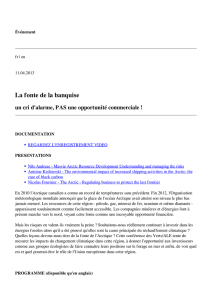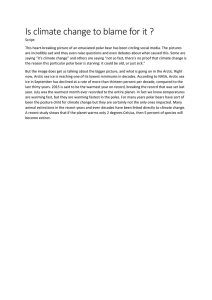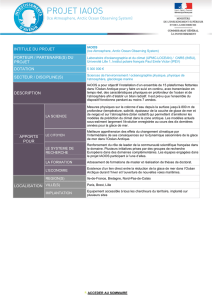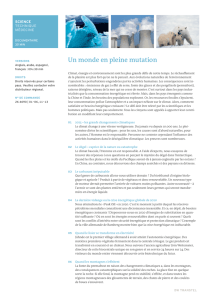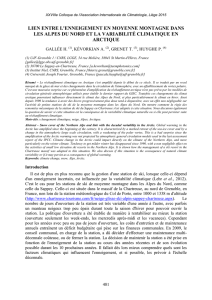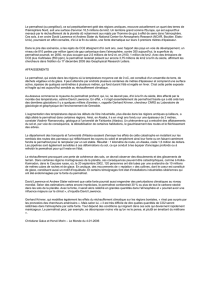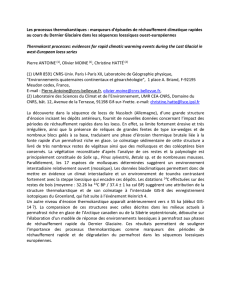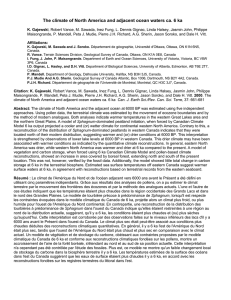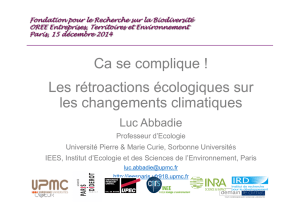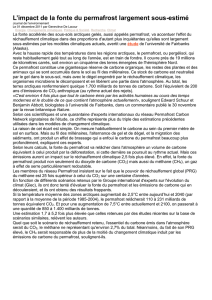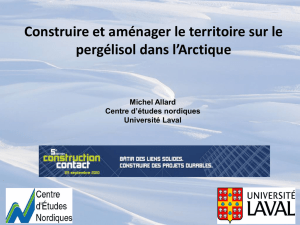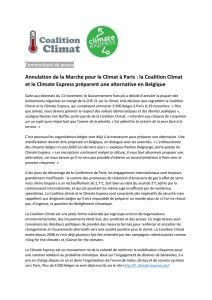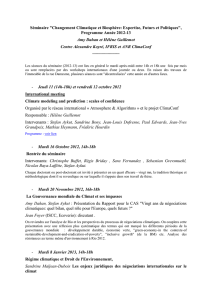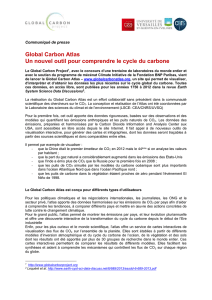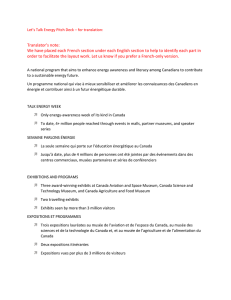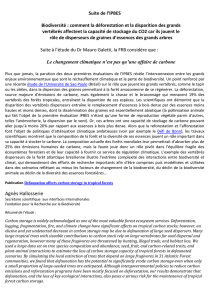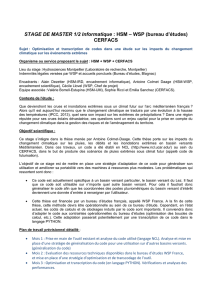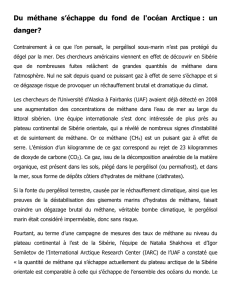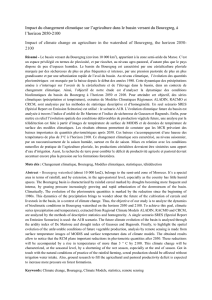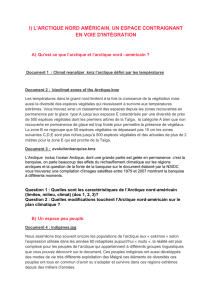unité mixte internationale pour la recherche en arctique
publicité
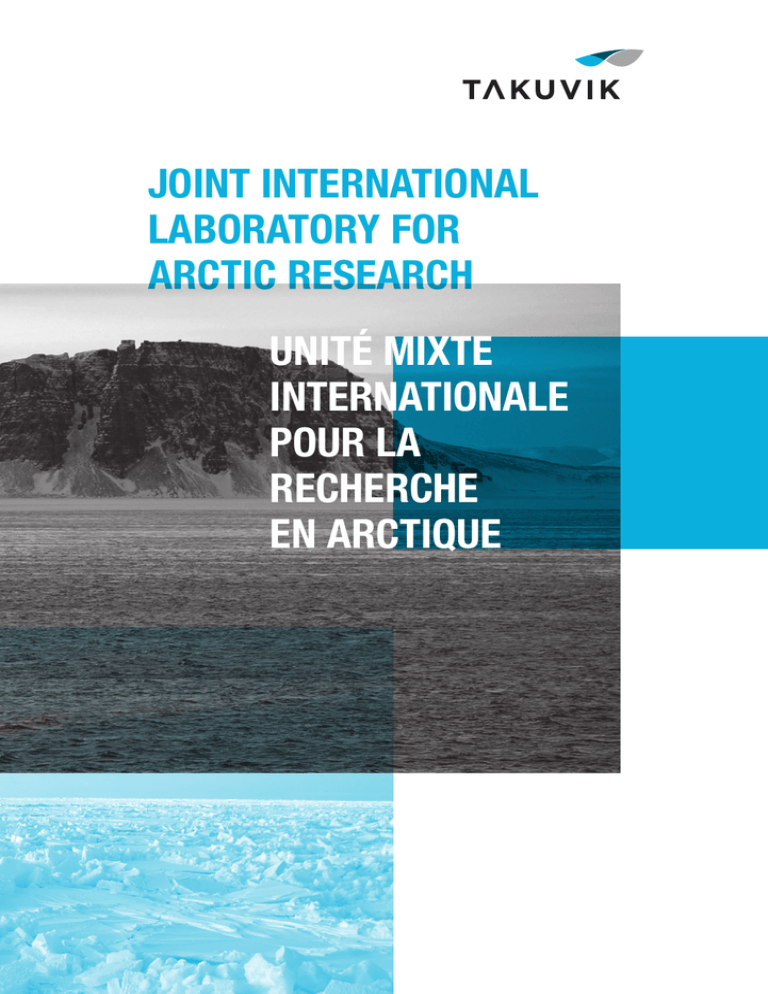
JOINT INTERNATIONAL LABORATORY FOR ARCTIC RESEARCH UNITÉ MIXTE INTERNATIONALE POUR LA RECHERCHE EN ARCTIQUE Takuvik was created in January 2011 through a partnership between University Laval (UL - Canada) and le Centre National de la Recherche Scientifique (CRNS - France) as a joint laboratory studying Arctic ecosystems. Takuvik’s scientific program is designed to study the impact of ongoing climatic and anthropogenic changes on Arctic and Subarctic marine and terrestrial ecosystems and geosystems. The Canada Excellence Research Chair in remote sensing of Canada’s new Arctic frontier, is one of the keystones of the program. Takuvik is located at UL, in Québec City, Canada, where CNRS employees are working on a full-time basis. CNRS has more than 35 such joint laboratories worldwide. L’Unité Mixte Internationale Takuvik fut créée en Janvier 2011. Elle est issue d’un partenariat entre l’Université Laval (UL - Canada) et le Centre National de la Recherche Scientifique (CNRS - France). Le programme de recherche de Takuvik vise à mieux comprendre l’impact des perturbations environnementales actuelles d’origine climatique et anthropique, sur les écosystèmes et les géosystèmes arctiques et subarctiques marins et terrestres. La Chaire d’Excellence en Recherche du Canada sur la télédétection de la nouvelle frontière arctique du Canada est l’un des piliers de ce programme. L’UMI Takuvik est située sur le campus de l’UL, à Québec, Canada, où des employés du CNRS y travaillent à temps plein. Dans cette même perspective de collaboration internationale, le CNRS a déjà crée plus de trente-cinq UMI similaires à celle de Takuvik à travers le monde. 2011 2014 REPORT OF THE FIRST MANDATE 12 BILAN DU PREMIER MANDAT 26 23 82 RESEARCHERS & PROFESSORS PROFESSEURS & CHERCHEURS POST-DOCTORAL FELLOWS STAGIAIRES POST-DOCTORAUX TECHNICIANS, ENGINEERS AND OTHER PROFESSIONALS TECHNICIENS, INGÉNIEURS ET AUTRES PROFESSIONNELS DIFFERENT NATIONALITIES NATIONALITÉS DIFFÉRENTES 22 BOOKS OR CHAPTERS LIVRES OU CHAPITRES DE LIVRE 151 INVITED CONFERENCES CONFÉRENCES INVITÉES 310 PUBLICATIONS IN HIGHLY-RANKED JOURNALS PUBLICATIONS DANS DES REVUES DE RANG A THAWING OF PERMAFROST AND CHANGES IN ARCTIC ECOSYSTEMS AND GEOSYSTEMS IMPACT OF CLIMATE CHANGE ON OPEN OCEAN ECOSYSTEMS GRADUATE STUDENTS ÉTUDIANTS GRADUÉS QUANTITATIVE REPORT ON 31 DECEMBER 2014 BILAN QUANTITATIF AU 31 DÉCEMBRE 2014 12 RESEARCH THEMES 1597 m2 LABORATORY SPACE ESPACE DE LABORATOIRE 2378 NUMBER OF FIELD DAYS / year JOURS DE TERRAIN / an 4752 COFFEES PER YEAR CAFÉS PAR ANNÉE THÈMES DE RECHERCHE DÉGEL DU PERGÉLISOL ET MODIFICATIONS DES GÉOSYSTÈMES ET ÉCOSYSTÈMES ARCTIQUES IMPACT DU CHANGEMENT CLIMATIQUE SUR LES ÉCOSYSTÈMES MARINS THAWING OF PERMAFROST AND CHANGES IN ARCTIC ECOSYSTEMS AND GEOSYSTEMS PERMANENTLY FROZEN SOILS CONTAIN A LARGE AMOUNT OF STORED CARBON, MAINLY IN THE FORM OF ORGANIC MATTER. IN THE CONTEXT OF GLOBAL WARMING, AS PERMAFROST THAWS, IT ELICITS GEOMORPHIC CHANGES AND THE TRANSFER OF THE ORGANIC RESERVOIR TOWARDS THERMOKARST PONDS AND THE OCEAN. DÉGEL DU PERGÉLISOL ET MODIFICATIONS DES GÉOSYSTÈMES ET ÉCOSYSTÈMES ARCTIQUES LES SOLS GELÉS EN PERMANENCE CONTIENNENT UNE QUANTITÉ IMPORTANTE DE CARBONE, PRINCIPALEMENT SOUS FORME DE MATIÈRE ORGANIQUE. DANS UN CONTEXTE DE RÉCHAUFFEMENT CLIMATIQUE, LE DÉGEL DU PERMAFROST ENGENDRE DES CHANGEMENTS GÉOMORPHOLOGIQUES ET UN TRANSFERT DU CARBONE ORGANIQUE VERS LES MARES DE THERMOKARST ET L’OCÉAN. THAWING OF PERMAFROST AND CHANGES IN ARCTIC ECOSYSTEMS AND GEOSYSTEMS DÉGEL DU PERGÉLISOL ET MODIFICATIONS DES GÉOSYSTÈMES ET ÉCOSYSTÈMES ARCTIQUES THERMAL REGIME OF PERMAFROST AND CARBON STORAGE Dominé, Allard RÉGIME THERMIQUE DU PERGÉLISOL ET STOCKAGE DE CARBONE Dominé, Allard The thermal regime of permafrost is strongly influenced by the insulating properties of the snow cover, which limits its winter cooling. These insulating properties are a function of climate, which determines the conditions of snow metamorphism. The growth of vegetation, induced by global warming, is another factor that modifies the physical properties of snow. Vegetation not only inhibits wind erosion and compaction but, given its dark colour, also increases the absorption of solar radiation, thus warming the snow. Permafrost stores about twice as much carbon as the atmosphere. Melting permafrost can release huge amounts of greenhouse gases into the atmosphere, which is one of the strongest positive climatic feedbacks. The strong relationship between snow and vegetation is likely to accelerate the melting of permafrost because warmer temperatures will increase shrub cover in the Arctic, thus improving the thermal insulation properties of the snow cover. Le régime thermique du pergélisol est fortement influencé par les propriétés isolantes du manteau neigeux qui limite son refroidissement hivernal. Ces propriétés isolantes sont fonction du climat, qui détermine les conditions du métamorphisme de la neige. La croissance de la végétation induite par le réchauffement est un facteur supplémentaire de modification des propriétés physiques de la neige, car elle limite l’action du vent comme l’érosion et la compaction, et de plus, la présence d’éléments de végétation sombres augmente l’absorption de radiation solaire, ce qui réchauffe la neige. Le pergélisol peut stocker environ deux fois plus de carbone que l’atmosphère. La fonte due au climat du pergélisol peut libérer d’énormes quantités de gaz à effet de serre dans l’atmosphère, ce qui représente une des plus fortes rétroactions climatiques positives. Il existe de fortes rétroactions positives entre la neige et la végétation qui sont susceptibles d’accélérer la fonte du pergélisol, car l’augmentation du couvert arbustif dans l’Arctique améliore les propriétés d’isolation thermique de la couverture de neige. 9 THAWING OF PERMAFROST AND CHANGES IN ARCTIC ECOSYSTEMS AND GEOSYSTEMS DÉGEL DU PERGÉLISOL ET MODIFICATIONS DES GÉOSYSTÈMES ET ÉCOSYSTÈMES ARCTIQUES GEOMORPHOLOGICAL CHANGES Allard, Lajeunesse As the climate warms, ice in the soil melts and the layer of thawed permafrost deepens, destabilizing the terrain and causing it to sink and lose load capacity. Infrastructures such as roads, airport runways, buildings and urbanized northern communities are affected. On slopes, the occurrence of landslides is increased. By studying the physical and thermal properties of permafrost and the different types of landforms subject to degradation, we will be able to propose, during the engineering phase, development strategies and design concepts that are tailored to regional governments, communities and industries. MODIFICATIONS GÉOMORPHIQUES Allard, Lajeunesse L’approfondissement de la couche active découlant du réchauffement climatique a pour conséquence de déstabiliser le terrain en provoquant des tassements et une perte de capacité portante à cause de la fonte de la glace contenue dans le pergélisol. Les infrastructures comme les routes, les pistes d’aviation, les bâtiments et celles des communautés nordiques urbanisées en sont affectées. Sur les pentes, l’occurrence de mouvements de terrain est accrue. En étudiant les propriétés physiques et thermiques du pergélisol et les différentes formes de terrain associées à sa dégradation, nous serons en mesure de proposer, en amont des travaux de génie, des stratégies de développement et des concepts de construction sur mesure pour les gouvernements régionaux, les communautés et les industries. 11 THAWING OF PERMAFROST AND CHANGES IN ARCTIC ECOSYSTEMS AND GEOSYSTEMS DÉGEL DU PERGÉLISOL ET MODIFICATIONS DES GÉOSYSTÈMES ET ÉCOSYSTÈMES ARCTIQUES DYNAMICS, MICROBIAL FUNCTION AND EVOLUTION OF NORTHERN LAKES Vincent, Antoniades, Lovejoy, Pienitz To better understand the land-water interactions in permafrost landscapes, we study microbial processes in the two extremes of the continuum, ultraoligotrophic lakes in the polar desert of the Canadian High Arctic (Nunavut) that are governed by autochthonous biological processes (phytoplankton and benthic algae) and thermokarst ponds in the low Arctic Tundra (Nunavik) where allochthonous processes dominate, such as the bacterial degradation of organic carbon that is associated with erosion and thawing permafrost. Paleolimnological methods enable us to reconstruct the role of microbial communities in past climate and determine their influence on biotic changes. Whereas, modelling oxygen dynamics and evaluating environmental controls on greenhouse gas emissions, particularly carbon dioxide and methane, in thermokarst ponds will enable us to better understand the importance of microbial processes both today and in the future. DYNAMIQUE, FONCTIONNEMENT MICROBIEN ET ÉVOLUTION DES LACS NORDIQUES Vincent, Antoniades, Lovejoy, Pienitz Pour mieux comprendre les interactions terre-eau dans les paysages de pergélisol, nos recherches portent sur les deux extrêmes de ce continuum : les lacs ultra-oligotrophes dans le désert polaire du haut arctique canadien (Nunavut), où les processus biologiques autochtones (phytoplancton et phytobenthos) jouent un rôle prédominant, et les mares de thermokarst dans la toundra du bas arctique (Nunavik) dominées par les processus allochtones, en particulier la dégradation bactérienne du carbone organique est associée au dégel et à l’érosion du pergélisol. Des méthodes paléolimnologiques sont appliquées afin d’établir les relations entre le climat et les communautés microbiennes en reconstruisant le climat à long terme et de déterminer son influence sur les changements biotiques. La modélisation de la dynamique de l’oxygène et l’évaluation de l’impact des facteurs de l’environnement sur les émissions de gaz à effet de serre (dioxyde de carbone et méthane) dans les mares de thermokarst, nous permettront de mieux comprendre l’importance des processus microbiens d’aujourd’hui et de demain. 13 THAWING OF PERMAFROST AND CHANGES IN ARCTIC ECOSYSTEMS AND GEOSYSTEMS DÉGEL DU PERGÉLISOL ET MODIFICATIONS DES GÉOSYSTÈMES ET ÉCOSYSTÈMES ARCTIQUES TRANSFER OF CONTINENTAL MATERIAL AND ITS FATE IN THE OCEAN Lajeunesse, Babin In the context of environmental and climate change, the flow of terrigenous sediment and carbon to marine environments varies on different temporal and spatial scales. To better understand this phenomenon, we study variations in relative sea level caused by climatic processes and glacier dynamics over short (10 yrs), medium (100 yrs), and long (1000 to a million yrs) terms. The sectors targeted by these analyzes are the west coast of Baffin Bay, the fjords of Ellesmere and Baffin Islands, Hudson Bay and its coasts and the western islands of the Canadian Arctic Archipelago and their passages. Remote sensing tools are used to quantify the riverine transfer of dissolved organic carbon and particulate matter from continental land mass to the ocean, its seasonal variability and the contribution of coastal erosion. TRANSFERT ET DEVENIR DES APPORTS CONTINENTAUX DANS L’OCÉAN Lajeunesse, Babin Pour mieux comprendre le flux de sédiments et de carbone des milieux continentaux vers les milieux marins sur différentes échelles spatiales et temporelles, des processus climatiques et la dynamique des glaciers sont étudiés sur le court (10 ans), moyen (100 ans) et long terme (mille à un million d’années). Différents changements environnementaux et variations du niveau de base de la mer (niveau marin relatif) causés par des mouvements tectoniques (isostasie, mouvements épirogéniques) sont étudiés. Les secteurs ciblés par ces analyses sont la côte ouest de la Baie de Baffin et les fjords des îles Ellesmere et de Baffin, la Baie d’Hudson et ses côtes ainsi que les îles de l’ouest de l’Archipel arctique canadien et leurs passages. Les outils de télédétection sont utilisés pour quantifer le transfert par les fleuves de carbone organique dissous et particulaire du continent à l’océan et en évaluer la variabilité saisonnière, et pour quantifier le transfert résultant de l’érosion côtière. 15 IMPACT OF CLIMATE CHANGE ON OPEN-OCEAN ECOSYSTEMS CLIMATE CHANGE HAS PROVOKED A DECREASE IN THE SUMMER EXTENT OF SEA-ICE. THE PHYTOPLANKTON SPRING BLOOM, WHICH DEVELOPS AT THE ICE EDGE ACCOUNTS FOR > 50% OF THE ANNUAL PRIMARY PRODUCTION IN THE ARCTIC OCEAN AND IS GENERALLY ASSOCIATED WITH A SIGNIFICANT TRANSFER OF ENERGY TO HIGHER TROPHIC LEVELS AND THE EXPORT OF CARBON TO MARINE SEDIMENTS. IMPACT DU CHANGEMENT CLIMATIQUE SUR LES ÉCOSYSTÈMES MARINS LE CHANGEMENT CLIMATIQUE A PROVOQUÉ UNE DIMINUTION DE L’ÉTENDUE ESTIVALE DE LA BANQUISE. LA FLORAISON DE PHYTOPLANCTON QUI SURVIENT AU PRINTEMPS DE CHAQUE ANNÉE EN LISÈRE DE BANQUISE, CONTRIBUE À PLUS DE 50% DE LA PRODUCTION PRIMAIRE ANNUELLE DANS L’OCÉAN ARCTIQUE, ET EST GÉNÉRALEMENT ASSOCIÉE À UN TRANSFERT IMPORTANT D’ÉNERGIE VERS LES NIVEAUX TROPHIQUES SUPÉRIEURS, ET À L’EXPORTATION DE CARBONE VERS LES SÉDIMENTS MARINS. 17 IMPACT OF CLIMATE CHANGE ON OPEN-OCEAN ECOSYSTEMS IMPACT DU CHANGEMENT CLIMATIQUE SUR LES ÉCOSYSTÈMES MARINS 18 DYNAMICS OF THE PHYTOPLANKTON SPRING BLOOM Babin, Dominé, Levasseur, Lovejoy, Massé, Tremblay, Lavaud LA DYNAMIQUE DE LA FLORAISON PRINTANIÈRE DU PHYTOPLANCTON Babin, Dominé, Levasseur, Lovejoy, Massé, Tremblay, Lavaud A spring phytoplancton bloom will be studied in Baffin Bay from its appearance under the ice in April until its decline in the ice-free area in July. The distribution of biogeochemical properties will be documented at different temporal and spatial scales using drifting profiling floats and gliders equipped with a range of physical and bio-optical sensors. Process studies will be carried out from an ice camp on the east coast of Baffin Island and aboard the research icebreaker Amundsen to assess the diversity, ecophysiology, and succession of phytoplankton species. The optical properties of sea water, ice and snow will be described in detail and an account will be made of the DMS emissions associated with the spring bloom. Un évènement de floraison printanière du phytoplancton sera étudié dans la Baie de Baffin, de son apparition sous la banquise avant la fonte des glaces en avril jusqu’à son déclin dans la zone libre de glace en juillet. La distribution des propriétés biogéochimiques sera documentée à différentes échelles de temps et d’espace grâce à l’utilisation des flotteurs-profileurs dérivants et planeurs sous-marins, tous équipés d’un éventail de capteurs physiques et bio-optiques. Des études de processus seront réalisées sur la banquise à partir d’un village Inuit de la côte est de l’Ile de Baffin et à bord du brise-glace de recherche Amundsen afin d’évaluer la diversité, l’écophysiologie et la succession des espèces phytoplanctoniques. Les propriétés optiques de l’eau de mer, de la glace et de la neige seront décrites en détail ainsi que les émissions de DMS associées à ces efflorescences de printemps. 19 IMPACT OF CLIMATE CHANGE ON OPEN-OCEAN ECOSYSTEMS IMPACT DU CHANGEMENT CLIMATIQUE SUR LES ÉCOSYSTÈMES MARINS 20 TRANSFER OF ORGANIC MATTER THROUGH THE FOOD CHAIN AND TOWARDS THE SEAFLOOR Fortier, Babin To study the impact of the spring bloom on the food chain and carbon fluxes, the entire length of the water column will be sampled with equipment including plankton nets, sediment traps, video systems for counting organic particles and zooplankton, and acoustic systems for detecting fish. In addition, sclerochronology will be used to establish a history of marine productivity. Vertical fluxes of particulate organic matter and the transfer of energy through the food chain will be estimated through measurement of zooplankton grazing and analyses of fish and larvae. LE TRANSFERT DE MATIÈRE ORGANIQUE À TRAVERS LA CHAINE TROPHIQUE ET VERS LE FOND DE L’OCÉAN Fortier, Babin Afin de déterminer l’impact de l’efflorescence printanière sur la chaine trophique et les flux de carbone, plusieurs dispositifs d’échantillonnage seront déployés du sommet de la colonne d’eau jusqu’aux fonds marins, y compris des filets à plancton, des trappes à sédiment et des systèmes vidéos pour dénombrer les particules et le zooplancton ainsi que des systèmes acoustiques pour détecter les poissons. De plus, la sclérochronologie (analyse des coquilles de bivalves) sera utilisée pour établir des séries temporelles du couplage pélagobenthique. De plus, grâce aux mesures de broutage par le zooplancton et à des analyses réalisées sur les poissons et leurs larves, les flux verticaux de matière organique particulaire et le transfert d’énergie et de matière à travers la chaine trophique pourront être estimés. IMPACT OF CLIMATE CHANGE ON OPEN-OCEAN ECOSYSTEMS IMPACT DU CHANGEMENT CLIMATIQUE SUR LES ÉCOSYSTÈMES MARINS 22 RECENT TRENDS 23 Babin, Dominé, Devred As the Arctic climate warms, more solar radiation is transmitted through the thinning and fragmented ice, promoting primary productivity in the water below the ice. However, this activity cannot be captured by remote sensing of ocean colour. Takuvik will develop a new approach that combines satellite data of different types to characterize transmittance through the snow-ice system and estimate primary productivity with a light-based model and nutrient data. Time series of spring bloom primary productivity dynamics will then be modelled to show its evolution over the last two decades. TENDANCES RÉCENTES Babin, Dominé, Devred Avec le réchauffement de l’Arctique, le rayonnement solaire accru est transmis par l’amincissement et la fragmentation de la glace de mer, favorisant ainsi la productivité primaire sous la glace. Cependant, la télédétection de la couleur de l’océan ne peut pas capturer cette activité sous la banquise. Takuvik va développer une nouvelle approche qui combine des données satellites de différents types pour caractériser la transmittance à travers le système neige-glace et pour estimer la productivité primaire grâce à un modèle basé sur la lumière et les nutriments. Ce modèle nous permettra d’établir des séries temporelles de la production primaire associée à l’efflorescence printanière pour montrer son évolution au cours des deux dernières décennies. FLOW CHART OF THE PRIMARY PRODUCTION USING WITH REMOTE SENSING DATA ORGANIGRAMME DE LA PRODUCTION PRIMAIRE UTILISANT DES DONNÉES DE TÉLÉDÉTECTION aphy(443) LEGEND / LÉGENDE chl Computed Inputs / Entrées modelisées Constants / Constantes Estimated Paramaters / Paramètres estimés Measured Inputs / Entrés mesurées Outputs / Sorties modelisées SIC Kd(550) Zgeometric (z) GREY / GRIS RED / ROUGE BLUE / BLEU GREEN / GREEN TEAL / SARCELLE Kd(490) Composite image of chlorophyll-a concentration from 2004-2014 for the month of September, estimated from Aqua-MODIS satellite data (data courtesy of OGEP-NASA). The colour palette indicates chlorophyll-a concentration, with increasingly warmer colours corresponding to higher concentrations. Image composite de la concentration moyenne de chlorophylle a en septembre entre 2004 et 2014, calculée à l’aide de données du capteur satellite Aqua-MODIS (données, gracieuseté de OGEP-NASA). La palette de couleur indique la concentration en chlorophylle-a, les couleurs les plus chaudes correspondant aux fortes concentrations. Figure prepared by / figure préparée par : Emmanuel Devred Atmospheric Parameters PUR(z, t) Ek(z) Ekmax PBmax PP REFERENCE Modified from/modifié de: Bélanger, S. and Babin, M. Algorithm Theoretical Basis Document (ATBD) for satellite-based Arctic Ocean Primary Productivity assessment, Version 1.0, March 2011. IMPACT OF CLIMATE CHANGE ON OPEN-OCEAN ECOSYSTEMS IMPACT DU CHANGEMENT CLIMATIQUE SUR LES ÉCOSYSTÈMES MARINS 24 PAST TRENDS FUTURE TRENDS Massé, Antoniades Maps, Tremblay, Fortier, Babin The spring phytoplankton bloom produces the bulk of the particulate carbon outside of the zones that are influenced by river outflows. It is important to determine how the bloom has been affected by past climate fluctuations and to what latitude the bloom has spread in past warm periods. High resolution temporal data from sediment cores collected in Baffin Bay and northern Ellesmere Island will be used to improve and calibrate the geochemical proxies and biomarkers for monitoring the bloom and the species that dominate it as well as environmental conditions (water temperature, presence of sea ice, ocean circulation). A coupled physical-biological model will be optimized to simulate the Arctic Ocean spring phytoplankton blooms in the future and to predict changes in the phytoplankton community structure and future implications for carbon transfer through the food chain. The production of organic matter in the Arctic is essentially restricted to the short bloom period, but the rest of the pelagic food web benefits throughout the year thanks to the ability of zooplankton (especially copepods) to accumulate large fat reserves. Data from in situ and laboratory studies of ecophysiology and succession of key plankton species will contribute to the development of a detailed zooplankton model, which will be validated by past observations and simulate future changes in plankton communities and their impact on higher levels of the food chain. TENDANCES PASSÉES 25 TENDANCES FUTURES Massé, Antoniades Maps, Tremblay, Fortier, Babin La floraison printanière, qui produit l’essentiel du carbone organique particulaire enfoui au-delà des zones influencées par les panaches de fleuves, a réagit à des fluctuations passées du climat. Nous souhaitons déterminer jusqu’à quelle latitude l’efflorescence printanière a pu s’étendre durant des périodes chaudes. Les données de haute résolution temporelle des carottes de sédiment de la Baie de Baffin et du nord de l’Ile d’Ellesmere permettront d’améliorer et d’étalonner les proxys géochimiques et biomarqueurs pour le suivi de la floraison et des espèces qui la dominent, et pour le suivi des conditions environnementales (température de l’eau, présence de glace de mer, circulation océanique). Un modèle physico-biologique sera optimisé pour simuler l’efflorescence printanière dans l’océan Arctique du futur et prévoir les changements dans la structure de la communauté phytoplanctonique et les implications pour le transfert de carbone dans la chaîne trophique. La production de matière organique dans l’Arctique est essentiellement limitée à la période courte de floraison, mais le reste du réseau trophique pélagique en bénéficie toute l’année grâce à la capacité du zooplancton (en particulier des copépodes) à la stocker sous forme d’importantes réserves de lipides. Les données recueillies in situ et lors d’expériences en laboratoire sur l’écophysiologie et la succession des espèces planctoniques clés, vont contribuer au développement d’un modèle détaillé. Il sera validé par des observations passées et simulera les changements futurs dans les communautés planctoniques et leurs impacts sur les niveaux supérieurs de la chaine trophique. REFERENCE: Forest et al. (2011) Biogenic carbon flows through the planktonic food web of the Amundsen Gulf (Arctic Ocean): A synthesis of field measurements and inverse modelling analyses. Progress in Oceanography. 91(4):410-436. Phototrophs >5 µm respiration 2.2 g C m -2 GPP -2 52.5 g C m Phototrophs <5 µm respiration 1.1 g C m -2 Residual carbon flux -2 7.7 g C m Bacterial respiration -2 19.5 g C m Microzooplankton respiration bac 7.9 g C m -2 mic lph cgl sph mlo chy ext ozo doc det Sedimentation -2 1.7 g C m 60% of the benthic C demand Mesozooplankton respiration 12.4 g C m -2 TEAM 14 RESEARCHERS FROM CNRS AND UNIVERSITÉ LAVAL WITH DIVERSE FIELDS OF EXPERTISE, INCLUDING OCEANOGRAPHY, MARINE OPTICS, GEOCHEMISTRY, MICROBIAL ECOLOGY, PALEOCEANOGRAPHY, LIMNOLOGY, GEOMORPHOLOGY, BIOCHEMISTRY, PERMAFROST AND SNOW PROPERTIES. ÉQUIPE 14 CHERCHEURS DU CNRS ET DE L’UNIVERSITÉ LAVAL PRÉSENTANT DES EXPERTISES DIVERSIFIÉES: L’OCÉANOGRAPHIE, L’OPTIQUE MARINE, LA GÉOCHIMIE, L’ÉCOLOGIE MICROBIENNE, LA PALÉOOCÉANOGRAPHIE, LA LIMNOLOGIE, LE GÉOMORPHOLOGIE, LA BIOGÉOCHIMIE, LE PERGÉLISOL ET LES PROPRIÉTÉS DE LA NEIGE. 14 Michel Allard Dermot Antoniades Marcel Babin Florent Dominé Louis Fortier Patrick Lajeunesse Johann Lavaud Maurice Levasseur Connie Lovejoy Fréderic Maps Guillaume Massé Reinhard Pienitz Jean-Éric Tremblay Warwick Vincent TEAM ÉQUIPE MARCEL BABIN LOUIS FORTIER WARWICK VINCENT REINHARD PIENITZ MICHEL ALLARD DERMOT ANTONIADES FLORENT DOMINÉ (UL and CNRS) Oceanographer, Takuvik Director Marine optics, light driven carbon fluxes and remote sensing of ocean colour. (UL) Oceanographer, Takuvik Deputy Director Dynamics of zooplankton and marine fish; Effect of climate change on Arctic ecosystems. (UL) Biologist Polar limnology, ecophysiology of cyanobacteria, impact of UV radiation on aquatic ecosystems. (UL) Paleolimnologist Paleoecology and bio-optics of northern lakes, eutrophication of lacustrine ecosystems. (UL) Geomorphologist Quaternary geology, coastal geomorphology, permafrost, climatology. (UL) Paleoecologist Paleolimnological reconstruc- tions of environmental change, polar ecosystems. (CNRS) Environmental physicist Snow physics, permafrost physics, snow-permafrost-vegetation- clImate interactions, snow chemistry. (UL) Océanographe, Directeur adjoint de Takuvik Dynamique du zooplancton et des poissons marins, Effet des change ments climatiques sur les éco- systèmes arctiques. (UL) Biologiste Limnologie polaire, écophysologie des cyanobactéries, impact du rayonnement UV sur les éco systèmes aquatiques. (UL) Paléolimnologiste Paléoécologie et bio-optique des lacs en milieu nordique, eutrophisation des écosystèmes lacustres. (UL) Géomorphologue Géomorphologie, géologie du quaternaire, milieux côtiers et pergélisol, climat. (UL) Paléoecologiste Reconstructions paléolimno logiques des changements environnementaux, ecosystèmes polaires. PATRICK LAJEUNESSE MAURICE LEVASSEUR CONNIE LOVEJOY GUILLAUME MASSÉ JOHANN LAVAUD FRÉDERIC MAPS JEAN-ÉRIC TREMBLAY (UL) Geographer Effects of environmental changes on the geomorphology of Arctic coastal zones, glacioisostasy, sedimentation. (UL) Oceanographer Plankton-climate interactions, production of Dimethyl sulfide (DMS) and NO2, ecophysiology of harmful algal blooms. (CNRS) Oceanographer Paleoceanography, diatom taxonomy. (CNRS) Marine ecophysiologist Physiology and ecophysiology of microalgae (diatoms), regulation of photosynthesis, chlorophyll fluorescence methodology. (UL) Oceanographer Numerical modeling of marine ecosystems, bio-physical interactions, zooplankton, pelagic ecosystems. (UL) Oceanographer Phytoplankton ecology, nutrients, biogeochemical carbon cycling. (UL) Géographe Effets des changements environ- nementaux sur la géomorphologie des zones côtières de l’Arctique; glacioisostasie, sédimentation. (UL) Océanographe Interactions plancton-climat, production de diméthyl sulfure (DMS) et NO2, écophysiologie des floraisons d’algues toxiques. (UL) Microbiologiste marin Microbiologie moléculaire de l’océan Arctique et de ses affluents. (CNRS) Océanographe Paleocéanographie; taxonomie des diatomées. (CNRS) Ecophysiologiste marin Physiologie et écophysiologie des microalgues (diatomées), régulation de la photosynthèse, méthodologie de la fluorescence chlorophyllienne. (UL) Océanographe Modélisation des écosystèmes marins, intéractions physique- biologie, zooplancton, écosystèmes pélagiques. (UL) Océanographe Écologie de phytoplancton, nutriments, cycle biogéochimique du carbone. (UL and CNRS) Océanographe, directeur de Takuvik Optique marine, flux de carbone induits par la lumière, télédétection de la couleur d’océan. (UL) Marine microbial ecologist Molecular microbiology of the Arctic Ocean and its tributaries. (CNRS) Physicien de l’environnement Physique de la neige, physique du pergélisol, climat arctique, interactions neige-pergélisol- climat-végétation, chimie de la neige. Pavillon Alexandre-Vachon, local 2078 1045, Avenue de la Médecine, Université Laval Québec (Québec) G1V 0A6 Canada T F 418 656-5193 418 656-2339 www.takuvik.ulaval.ca We acknowledge the contribution of Jean-Jacques Pangrazi / biosphoto who provided the majority of the photographs for this document. Additional photo credits are extended to Louise Leblanc, Reinhard Pienitz, Warwick Vincent and Guislain Becu. Design : Criterium Nous reconnaissons la contribution de Jean-Jacques Pangrazi / biosphoto qui a fourni la majorité des photographies pour ce document. Des crédits photos supplémentaires vont à Reinhard Pienitz, Louise Leblanc, Warwick Vincent et Guislain Becu. Design : Criterium
